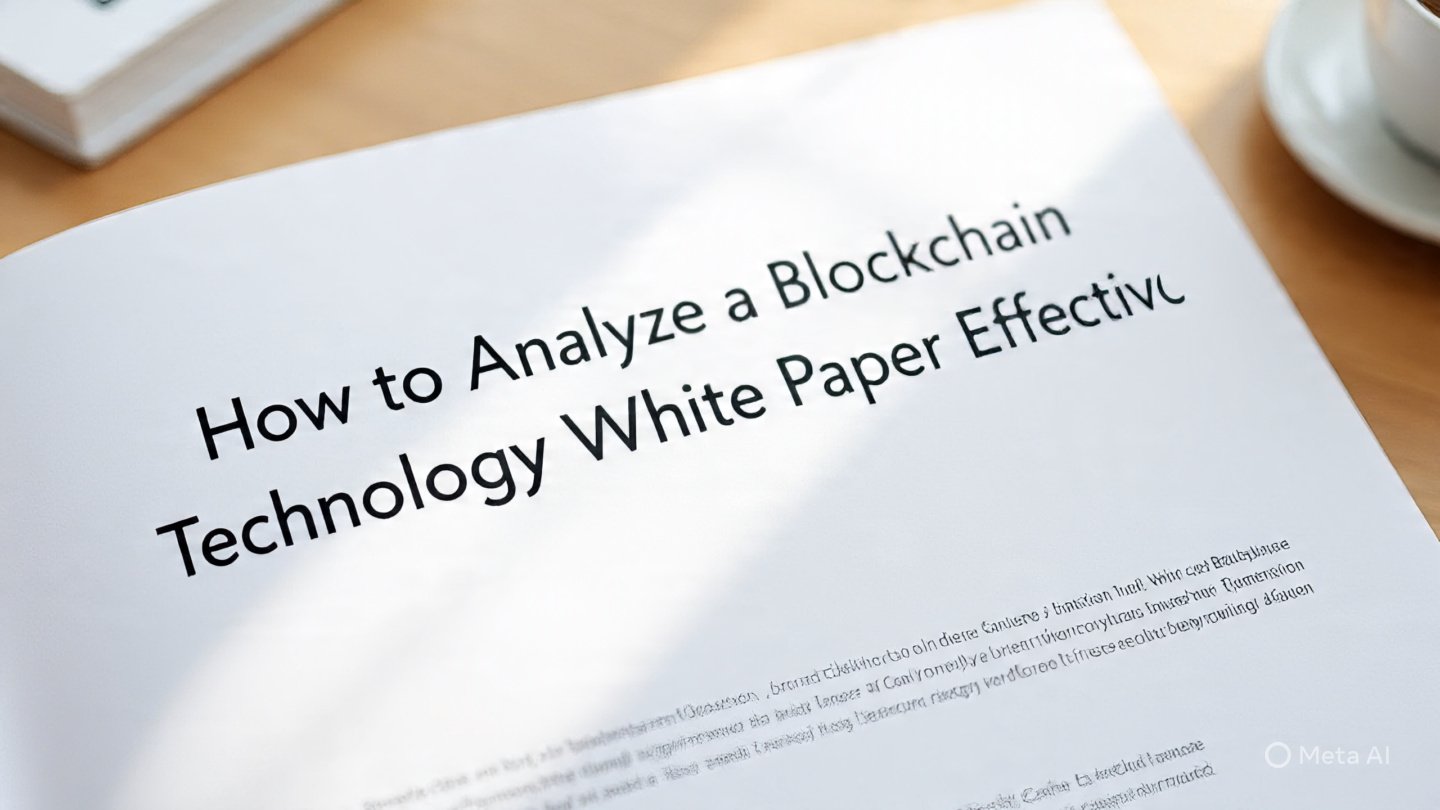The blockchain technology white paper represents the foundational document that outlines the technical specifications, economic models, and strategic vision of any blockchain project. Whether you’re an investor, developer, or technology enthusiast, understanding how to read and analyze a blockchain technology white paper is crucial for making informed decisions in the rapidly evolving cryptocurrency landscape. These comprehensive documents serve as the blueprint for revolutionary technologies that are reshaping industries from finance to supply chain management, providing detailed insights into the project’s methodology, implementation strategy, and long-term viability.
What is a Blockchain Technology White Paper?
A blockchain technology white paper is a detailed technical document that presents the problem a blockchain project aims to solve, the proposed solution, and the methodology for implementation. Initially popularized by Satoshi Nakamoto’s Bitcoin white paper in 2008, these documents have become the gold standard for introducing new blockchain concepts to the world.
Key Components of Every Blockchain White Paper
Every comprehensive blockchain technology white paper typically includes several essential sections that provide stakeholders with a complete understanding of the project:
Executive Summary and Problem Statement The opening section clearly defines the existing problem in the market or technology landscape that the blockchain solution addresses. This section should immediately capture the reader’s attention and establish the project’s relevance.
Technical Architecture and Implementation This crucial section details the underlying technology, consensus mechanisms, smart contract functionality, and system architecture. It explains how the blockchain network will operate, including node requirements, transaction processing, and security measures.
Economic Model and Tokenomics Most blockchain projects include detailed information about their token distribution, utility, and financial incentives. This section outlines how the project will sustain itself financially and create value for participants.
Use Cases and Applications Real-world applications demonstrate the practical value of the blockchain solution. This section should provide concrete examples of how the technology will be implemented across various industries.
How to Analyze a Blockchain Technology White Paper Effectively

Understanding how to evaluate a blockchain technology white paper properly can save investors from costly mistakes and help identify promising opportunities in the cryptocurrency market.
Technical Evaluation Framework
Assess the Problem-Solution Fit. Begin by examining whether the proposed blockchain solution genuinely addresses a real-world problem. Many projects create solutions that look for problems, rather than addressing existing inefficiencies.
Evaluate Technical Feasibility Review the technical specifications to determine if the proposed implementation is realistic given current technological constraints. Look for innovative approaches that advance the blockchain technology space.
Examine the Team’s Credentials. While not always explicitly stated in the white paper itself, research the development team’s background and previous experience with blockchain projects.
Red Flags to Watch For
Several warning signs in a blockchain technology white paper should raise immediate concerns:
- Vague or unrealistic technical claims without proper explanation
- Lack of clear use cases or market analysis
- Overpromising returns or guaranteed profits
- Missing technical details about consensus mechanisms
- Plagiarized content from other projects
Essential Elements of Successful Blockchain White Papers
The most successful blockchain projects share common characteristics in their white paper documentation that set them apart from less viable alternatives.
Clear Value Proposition
A strong blockchain technology white paper articulates a clear value proposition that explains why blockchain technology is the optimal solution for the identified problem. It should demonstrate advantages over existing centralized or traditional solutions.
Detailed Technical Specifications
Consensus Mechanism Design The document should clearly explain the chosen consensus algorithm (Proof of Work, Proof of Stake, Delegated Proof of Stake, etc.) and justify why it’s appropriate for the specific use case.
Scalability Solutions Modern blockchain projects must address scalability concerns. The white paper should outline how the network will handle increased transaction volume and user adoption.
Security Measures Comprehensive security protocols and risk mitigation strategies should be thoroughly documented, including how the system will handle potential attacks or vulnerabilities.
Roadmap and Development Timeline
A realistic development roadmap with achievable milestones demonstrates the team’s commitment to execution and provides investors with clear expectations for project development.
Industry Applications of Blockchain Technology White Papers
Blockchain technology white papers span numerous industries, each presenting unique challenges and solutions that demonstrate the versatility of distributed ledger technology.
Financial Services and DeFi
Decentralized Finance (DeFi) projects represent some of the most innovative blockchain applications. These white papers typically focus on:
- Automated market makers and liquidity provision
- Yield farming and staking mechanisms
- Cross-chain interoperability solutions
- Regulatory compliance frameworks
Supply Chain and Logistics
Supply chain blockchain white papers address transparency, traceability, and efficiency improvements in global logistics networks. Key focus areas include:
- Product authenticity verification
- Real-time tracking and monitoring
- Automated compliance reporting
- Supplier verification systems
Healthcare and Medical Records
Healthcare blockchain projects tackle patient data privacy, interoperability, and security challenges through innovative solutions outlined in their white papers:
- Secure patient data sharing
- Drug traceability and anti-counterfeiting
- Clinical trial data integrity
- Healthcare provider verification
Common Mistakes When Reading Blockchain White Papers
Many investors and enthusiasts make critical errors when analyzing blockchain technology white papers, leading to poor investment decisions or a misunderstanding of project capabilities.
Focusing Only on Hype and Marketing Language
Practical white paper analysis requires looking beyond marketing terminology to understand the underlying technical merit and real-world applicability of the proposed solution.
Ignoring Market Analysis and Competition
A comprehensive blockchain technology white paper should include thorough market analysis and competitive landscape evaluation. Projects that ignore existing solutions or fail to differentiate themselves face significant adoption challenges.
Overlooking Implementation Challenges
Technical feasibility extends beyond theoretical concepts to practical implementation challenges, including regulatory compliance, user adoption, and integration with existing systems.
The Evolution of Blockchain White Papers

The format and content of blockchain technology white papers have evolved significantly since Bitcoin’s original nine-page document introduced the concept of decentralized digital currency.
From Simple Concepts to Complex Ecosystems
Early blockchain white papers focused primarily on peer-to-peer electronic cash systems. Modern documents address complex multi-chain ecosystems, cross-protocol interoperability, and sophisticated innovative contract platforms.
Regulatory Considerations and Compliance
Contemporary blockchain projects must address regulatory compliance in their white papers, particularly projects involving tokenized assets or financial services applications.
Integration with Traditional Systems
Modern blockchain technology white papers increasingly address integration challenges with existing infrastructure, demonstrating practical pathways for adoption rather than complete system replacement.
Future Trends in Blockchain Documentation
The blockchain industry continues to mature, and white paper standards are evolving to meet increasing sophistication in both technology and regulatory requirements.
Environmental Sustainability
Growing environmental concerns have led to increased focus on energy-efficient consensus mechanisms and carbon-neutral blockchain solutions in project documentation.
Interoperability and Cross-Chain Solutions
Future blockchain projects increasingly emphasize interoperability solutions that enable seamless value transfer and data sharing across different blockchain networks.
Integration with Emerging Technologies
Modern blockchain white papers often incorporate artificial intelligence, Internet of Things (IoT), and edge computing technologies to create comprehensive solutions for complex real-world problems.
Conclusion
Understanding how to analyze a blockchain technology white paper properly is an essential skill for anyone involved in the cryptocurrency and blockchain space. These foundational documents provide crucial insights into project viability, technical innovation, and long-term potential that can significantly impact investment decisions and technology adoption strategies.
The key to successful white paper analysis lies in maintaining a balance between technical understanding and practical skepticism. Look for projects that demonstrate clear problem-solution fit, realistic implementation strategies, and transparent communication about both opportunities and challenges.



















